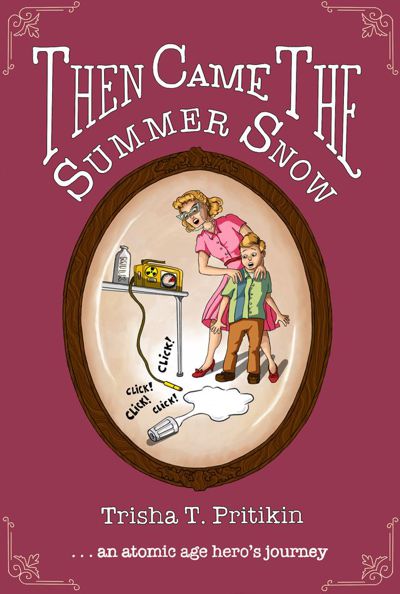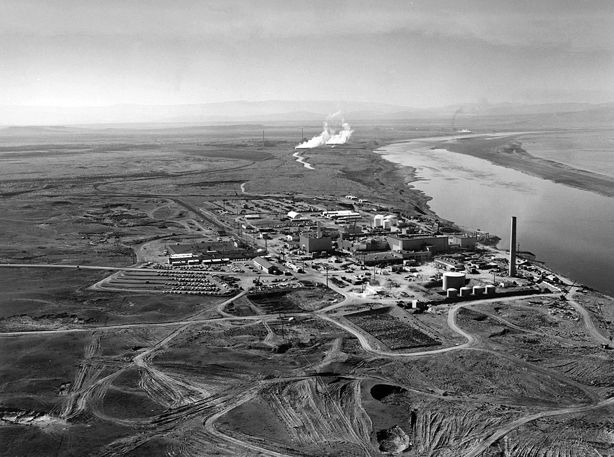
In 1958, Edith Higgenbothum, a housewife in Richland, Washington, downwind of the massive Hanford nuclear weapons production site, discovers that the milk her young son Herbie drinks contains radioactive iodine from Hanford’s secret fallout releases. Radioactive iodine can damage the thyroid, especially in children.
When Herbie is diagnosed with aggressive thyroid cancer, Edith allies with mothers of children with thyroid cancer and leukemia in communities blanketed by fallout from Nevada Test Site A-bomb tests on a true atomic age hero’s journey to save the children.

Guest Post: Fallout from the Hanford Production site
The primary US atomic bomb test site was the Nevada Test Site (NTS), where above-ground tests began in 1951. At least twenty-three above ground or underground nuclear tests occurred outside the NTS at various locations within the US, including Alaska, New Mexico, Colorado, and Mississippi. Atomic bombs and, later, much more powerful hydrogen (thermonuclear) bombs, were tested in the Pacific near the Marshall Islands, in an area called the “Pacific Proving Grounds.”
Hanford was not a testing site. It was a plutonium production site, where the plutonium for the world’s first test of an atomic bomb, the Trinity Test (detonated July 16, 1945) near Alamogordo, New Mexico, and the plutonium for “Fat Man,” the A-bomb that decimated Nagasaki on August 9, 1945, were produced.
As part of the manufacturing process, the Hanford site secretly released the radioactive byproducts of plutonium production, beginning in November 1944 with start-up of the site, and continuing for more than four decades thereafter. Airborne radiation was released through Hanford’s two hundred foot tall exhaust stacks, and liquid and solid radioactive byproducts were dumped directly into the Columbia River, which ran alongside the huge site and provided water used to cool its multiple production reactors.

Airborne radioactive fallout blanketed eastern Washington State, northern Oregon, the Idaho panhandle, and entered into western Montana. Hanford’s fallout also entered British Columbia. Radioactive byproducts dumped into the Columbia negatively impacted communities downriver of Hanford, all the way to the mouth of the river where it empties into the Pacific.
Families in Hanford’s downwind and downriver communities now suffer from the same radiation-related cancers and other illnesses found in families downwind of the Nevada Test Site and other test sites mentioned above. Thyroid cancer, leukemia, other radiation-related cancers, infertility, still births, neonatal deaths, birth defects, and autoimmune disorders are among the disabling health outcomes diagnosed in the downwinders and those living downstream from Hanford.
In Then Came the Summer Snow, I chose to focus on just one of the hundreds of radioactive byproducts that wafted out of the Hanford site. That substance is radioactive iodine, or I-131. It was known since before start-up of the Hanford site that I-131 can inflict severe damage on the thyroid. Infants and children are particularly susceptible to thyroid damage. Numerous children downwind of Hanford and the NTS developed thyroid cancer as the result of their childhood exposure to I-131.
Set in 1958, Then Came the Summer Snow, while focused with a difficult topic- childhood cancers from fallout- is written via dark humor, and is infused with the culture of the “nifty fifties.”
The extent of the human toll of the US nuclear weapons production and testing program may never be known. It is hoped that this story, an atomic age hero’s journey, helps shine a light on a dark period in US history.
Universal Buy Link: https://books2read.com/u/bOOqKE
This title is available to read on #KindleUnlimited
Meet Tricia Pritikin

Trisha is an internationally known advocate for fallout-exposed populations downwind of nuclear weapons production and testing sites. She is an attorney and former occupational therapist.
Trisha was born and raised in Richland, the government-owned atomic town closest to the Hanford nuclear weapons production facility in southeastern Washington State. Hanford manufactured the plutonium used in the Trinity Test, the world’s first test of an atomic bomb, detonated July 16,1945 at Alamogordo, NM, and for Fat Man, the plutonium bomb that decimated Nagasaki on August 9, 1945. Beginning in late 1944, and for more than forty years thereafter, Hanford operators secretly released millions of curies of radioactive byproducts into the air and to the waters of the Columbia River, exposing civilians downwind and downriver. Hanford’s airborne radiation spread across eastern Washington, northern Oregon, Idaho, Western Montana, and entered British Columbia.
Trisha suffers from significant thyroid damage, hypoparathyroidism, and other disabling health issues caused by exposure to Hanford’s fallout in utero and during childhood. Infants and children are especially susceptible to the damaging effects of radiation exposure.
Trisha’s first book, The Hanford Plaintiffs: Voices from the Fight for Atomic Justice, published in 2020 by the University Press of Kansas, has won multiple awards, including San Francisco Book Festival, 1st place (history); Nautilus Silver award (journalism and investigative reporting); American Book Fest Book Awards Finalist (US History); Eric Hoffer Awards, Shortlist Grand Prize Finalist; and Chanticleer International Book Awards, 1st Place, (longform journalism). The Hanford Plaintiffs was released in Japanese in 2023 by Akashi Shoten Publishing House, Tokyo.
Connect with Trisha
Website: www.trishapritikin.com
Twitter / X: https://x.com/TrishaPritikin
Facebook: https://www.facebook.com/trishapritikinfightingback/
Pinterest: https://www.pinterest.com/triesq/
Amazon Author Page: https://www.amazon.com/stores/Trisha-T.-Pritikin/author/B086WVVNTY
Goodreads: https://www.goodreads.com/author/show/19583157.Trisha_T_Pritikin
Atomic Heritage Foundation Interview: https://ahf.nuclearmuseum.org/ahf/profile/trisha-pritikin/